15 Dazzling Types of Daffodils flowers
Types of daffodils are a wonderful choice to spring garden, boasting a range of colors from gold, yellow, cream, orange, salmon, pink, and white. These stunning flowers are part of the Narcissus genus and come in a variety of hybrid bulbs that have been cultivated over time to highlight desirable traits. These bulbs have given rise to many different types of daffodils. Daffodils are easy to grow and will readily naturalize in a lawn or woodland area, creating a colorful blanket of blooms in the spring. Additionally, they work well for filling empty garden spaces that will be occupied by later blooming perennials. Another advantage of some types of daffodils is that they are deer-resistant, making them an ideal choice for gardeners dealing with deer damage.
Daffodils have been in cultivation for hundreds of years, and their diverse range of types of daffodils has led to a complicated classification system. Most serious growers use the Royal Horticultural Society’s classification system, which sorts daffodils into 13 divisions based on their flower shape and genetic heritage. This system ensures that each types of daffodils variety is accurately described, making it easier for gardeners to select the perfect daffodil for their needs.

If you’re looking to expand your spring garden’s color palette, consider adding one or more of these dazzling types of daffodils varieties. With a range of hues, heights, and bloom times, these daffodils are sure to brighten up your landscape and provide a stunning display of spring color
1. 'Petit Four' Daffodil
- Native Area:Nursery hybrid
- USDA Hardiness Zones:3–8
- Height:12–18 inches
- Sun Exposure:Full sun to partial shade
Named after the popular French pastry, the ‘Petit Four’ is a visually delightful addition to any spring garden. This plant is known for its fluffy appearance and showy display of blooms, which typically appear in March. It belongs to the fourth division of daffodils, which includes varieties that have multiple flowers on each stem and extra petals per flower. This gives the ‘Petit Four’ a more extravagant and ornamental appearance, making it an excellent choice for adding visual interest to your floral arrangements. However, it’s important to note that over time, naturalized bulbs of ‘Petit Four’ may revert to a single-flower form, which is still beautiful but lacks the frilly appearance of the original cultivar. Nevertheless, this daffodil variety remains a popular choice among gardeners for its unique and eye-catching blooms.
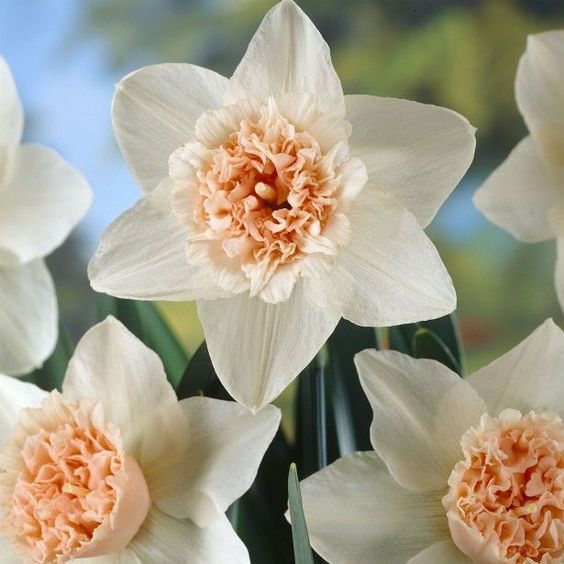
2. 'New Baby' Daffodil
- Native Area:Nursery hybrid
- USDA Hardiness Zones:5–9
- Height:4–8 inches
- Sun Exposure:Full sun
New Baby’ is a lovely miniature hybrid daffodil variety that is perfect for adding a touch of brightness to any garden or outdoor space. This variety is particularly striking when planted in hanging baskets or containers, where its yellow-edged petals and sweet fragrance can be fully appreciated up close. Despite their small size, each bulb produces three to four blooms, which is a wonderful way to increase the number of flowers in your garden. Blooming in late spring, ‘New Baby’ falls into division 7 of the Royal Horticultural Society’s daffodil classification system, known as jonquillas. This division is characterized by thin, rush-like leaves and one to five flowers per stem. If you’re looking for a delicate yet cheerful addition to your garden, ‘New Baby’ is an excellent choice.
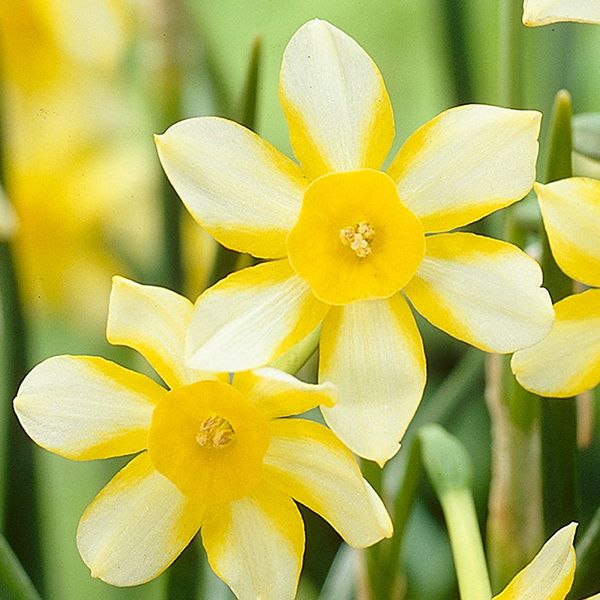
3. 'Crewenna' Daffodil
- Native Area:Nursery hybrid
- USDA Hardiness Zones:3–8
- Height:18–20 inches
- Sun Exposure:Full sun to partial shade
Belonging to division 1, ‘Crewenna’ is a type of daffodil with the traditional trumpet shape that is highly sought after by gardeners. It has a central cup (known as the corona) that is at least as long as its outer petals, which adds to its visual appeal. Blooming in early spring, even in the face of unpredictable frosts and freezes, this daffodil cultivar is one of the taller varieties, making it an excellent choice for adding a touch of height and visual interest to the spring garden.
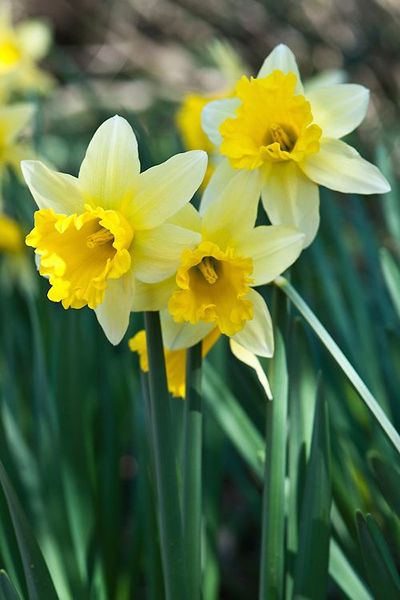
4. Red Devon' Daffodil
- Native Area:Nursery hybrid
- USDA Hardiness Zones:3–8
- Height:16–18 inches
- Sun Exposure:Full sun to partial shade
Despite efforts by daffodil breeders, a true red color in daffodils has yet to be achieved. However, ‘Red Devon’ comes close with its striking red-orange cup that is surrounded by yellow petals. This cultivar was created by an English hybridizer and named after the red cattle of Devonshire. ‘Red Devon’ blooms in mid-spring and is sure to catch the eye in any flower bed or border. This daffodil variety falls into division 2, which includes large-cupped flowers that have cups at least half the length of the outer petals but less than their total length. With its unique color and impressive blooms, ‘Red Devon’ is a standout in any spring garden.
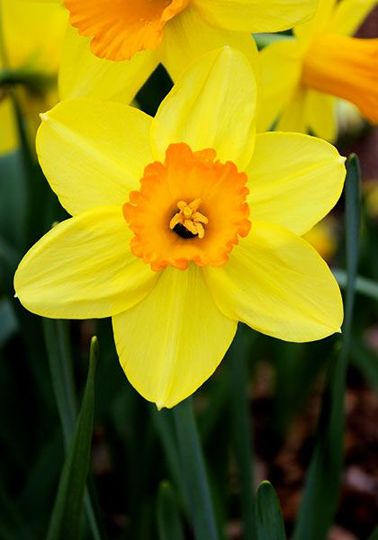
5. 'Valdrome' Daffodil
Native Area: Nursery hybrid
USDA Hardiness Zones: 3–8
Height: 12–26 inches
Sun Exposure: Full sun
Valdrome is a unique daffodil variety that falls into division 11, which is characterized by the split-cupped collar. Its distinguishing feature is the open and ruffled yellow cup that lies within its white petals, as opposed to the typical trumpet shape found in other daffodils. Its appearance is reminiscent of a daylily, hinting at what summer may bring. Although this daffodil may resemble a summer flower, it is a late-blooming variety that often waits until May to bloom. The ‘Valdrome’ is a beautiful addition to any garden and will undoubtedly draw attention with its distinct split-cupped collar and vibrant colors.

6. 'Sir Winston Churchill' Daffodil
Native Area: Nursery hybrid
USDA Hardiness Zones: 4–8
Height: 10–16 inches
Sun Exposure: Full sun to partial shade
The regal ‘Sir Winston Churchill’ daffodil is a late-blooming variety that produces tall and fragrant flowers that are definitely worth the wait. This variety typically blooms in late April or early May, sporting creamy white petals with bright yellow centers. Each bulb produces an average of four flower stems, and each stem can have as many as four flowers. The frilly double row of petals gives ‘Sir Winston Churchill’ a resemblance to carnations, making them a great addition to any cut flower arrangement. This daffodil falls into division 4, which includes varieties with double petals. With its majestic appearance and lovely fragrance, ‘Sir Winston Churchill’ is a standout in any spring garden.

7. 'Tahiti' Daffodil
- Native Area:Nursery hybrid
- USDA Hardiness Zones:4–8
- Height:12–18 inches
- Sun Exposure:Full sun to partial shade
During the 1950s, a daffodil breeder from Ireland introduced a line of flowers with intriguing names, including ‘Tahiti.’ He particularly favored daffodils that boasted deep orange cups, which provided a remarkable contrast to their vibrant yellow petals. This cultivar is a division 4 daffodil, which is a type with more flowers per stem and more petals per flower. ‘Tahiti’ has large flowers, typically about four inches across, and blooms in mid-season, typically appearing in April in most regions.
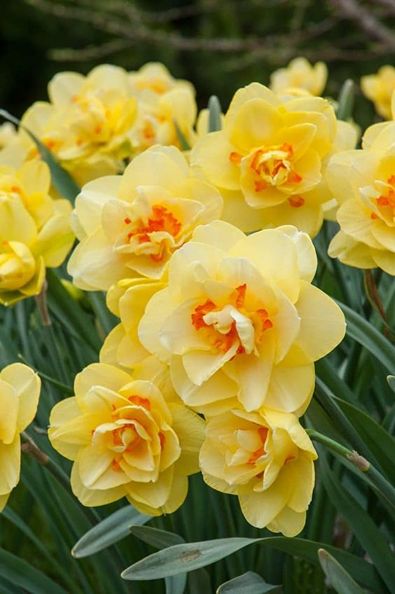
8. 'Ziva' Paperwhite
- Native Area: Mediterranean
- USDA Hardiness Zones: 8–10
- Height: 16–18 inches
- Sun Exposure: Full sun to partial shade
When it comes to the scent of paperwhites, gardeners can have different opinions. While some might describe it as sweet, others might find it musky. But there’s one thing they can all agree on: paperwhites are an easy plant to grow indoors. With a shallow container, a layer of stones or gravel, and water, you can enjoy the brilliant white flowers that will bloom after several weeks. ‘Ziva’ is an early bloomer among paperwhites, typically flowering in early spring. This cultivar belongs to division 8, known as the tazetta group, which includes plants with short cups and highly fragrant flowers.
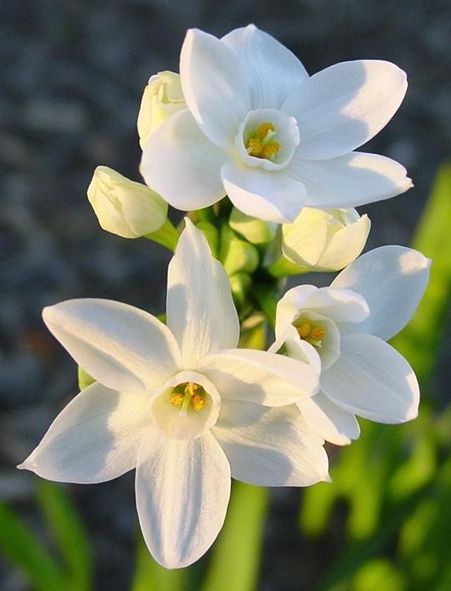
9. 'Toto' Daffodil
- Native Area:Nursery hybrid
- USDA Hardiness Zones:4–11
- Height:6–12 inches
- Sun Exposure:Full sun
‘Toto’ is a great choice if you’re looking for a small daffodil with brilliant white petals that can contrast beautifully with other colorful spring flowers. This dwarf daffodil is less than a foot tall and blooms early in the season, making it ideal for container gardening or to border the front of a garden bed. The star-shaped flowers on each stem can number up to three, with each flower sporting white petals and a pale yellow cup. As a member of division 12, ‘Toto’ is a hybrid variety that doesn’t fit neatly into any other category, being either a miscellaneous daffodil or a hybrid with parents from different divisions.
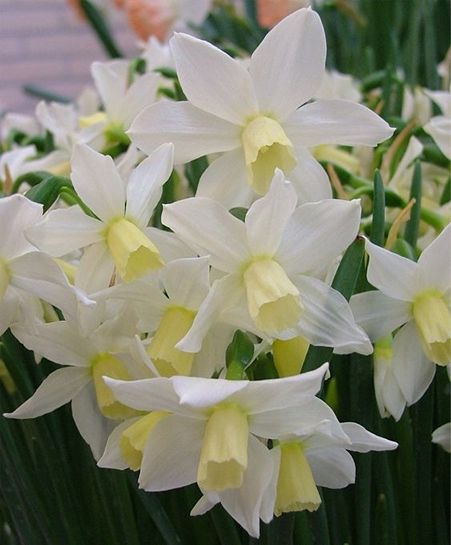
10. 'Ice Follies' Daffodil
- Native Area:Nursery hybrid
- USDA Hardiness Zones:3–9
- Height:12–18 inches
- Sun Exposure:Full sun to partial shade
‘Ice Follies’ is a daffodil cultivar that produces stunning flowers on tall stems in the early to mid-spring season. This daffodil variety has six white petals, each about four inches across, with a frilled yellow cup that adds a charming touch. It’s a great plant that can naturalize easily and return year after year. The cultivar was created in the Netherlands and is known to bloom in vast fields, especially during the springtime. ‘Ice Follies’ is a large-cupped daffodil belonging to division 2, which includes flowers with cups at least half the length of the outer petals but less than their total length. It’s a “late mid-season” bloomer, usually appearing in March or April in most regions.

11. 'Rapture' Daffodil
- Native Area:Nursery hybrid
- USDA Hardiness Zones:3–8
- Height:12–18 inches
- Sun Exposure:Full sun to partial shade
‘Rapture’ is a division 6 daffodil that has a unique feature – a protruding cup with swept-back petals. This cultivar produces lovely sulfur-lemon flowers that grow one per stem and have blooms bent at an acute angle to the stem. These striking blooms not only make a beautiful addition to any garden but are also good for cutting and can attract bees and other pollinators. ‘Rapture’ is one of the earlier daffodils to bloom, typically appearing in March, and its bright yellow blooms add a cheerful touch to the early spring landscape.
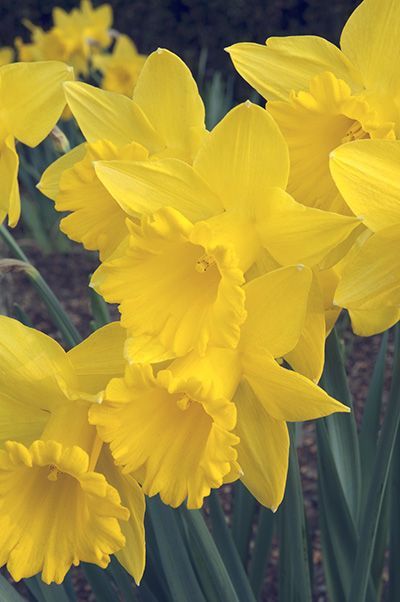
12. 'Mary Gay Lirette' Daffodil
- Native Area:Nursery hybrid
- USDA Hardiness Zones:3–8
- Height:12–18 inches
- Sun Exposure:Full sun to partial shade
The ‘Mary Gay Lirette’ daffodil is a unique and striking addition to any spring garden. Unlike most pink daffodils, which tend to lean towards shades of apricot or salmon, this variety boasts a true pink color that is sure to catch the eye. What’s more, the extremely ruffled, split-cupped collar of its blooms gives it a distinctive appearance that makes it nearly unrecognizable as a daffodil, more akin to a peony. This cultivar usually blooms in April and belongs to division 11, which comprises daffodils with center cups that are split along at least half their length, giving the flowers a full and fluffy appearance. Its stunning blooms are sure to attract attention and admiration from any garden visitors.
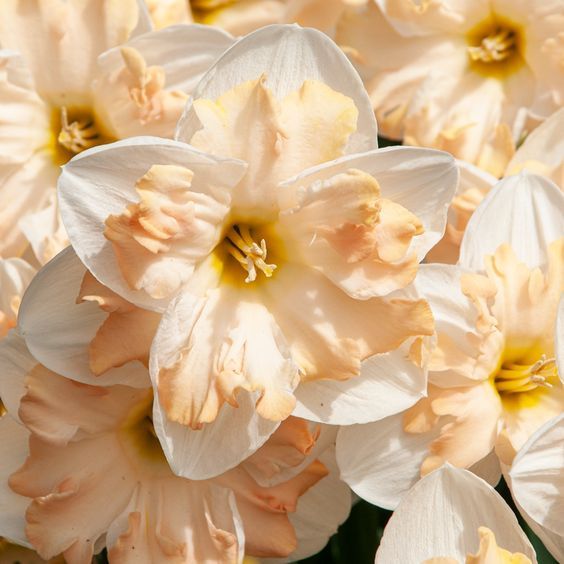
13. 'Dutch Master' Daffodil
- Native Area:Nursery hybrid
- USDA Hardiness Zones:3–9
- Height:14–16 inches
- Sun Exposure:Full sun
The ‘Dutch Master’ daffodil is a highly regarded cultivar known for its bright yellow flowers that showcase the classic trumpet shape. It is derived from the ‘King Alfred’ cultivar, which is one of the oldest daffodil cultivars. This cultivar is popular globally and generally blooms in early to mid-spring, adding a burst of color to gardens. ‘Dutch Master’ bulbs multiply easily, creating clusters of flowers that are perfect for naturalized wildflower gardens. The ‘Dutch Master’ falls under division 1 daffodils, in which the corona (central trumpet or cup) is equal to or longer than the length of the outer petals, also known as perianth.

14. 'Pheasant's Eye Daffodil
- Native Area:Central and southern Europe; widely naturalized in North America
- USDA Hardiness Zones: 3–9
- Height:12–18 inches
- Sun Exposure:Full sun to partial shade
The pheasant’s eye daffodil, also called poet’s narcissus, is a native plant species that was one of the first narcissus to be cultivated and is still a popular choice. It has the unique ability to multiply rapidly into large but not invasive colonies, like many other daffodil species. Its delightful aroma and pure white flowers, which bloom in late spring, surround a small yellow cup with red edges. This type of daffodil is commonly used to add fragrance to perfumes, with some comparing its scent to that of jasmine or hyacinth. Pheasant’s eye belongs to division 9, which is dedicated to N. poeticus and the cultivars derived from it.
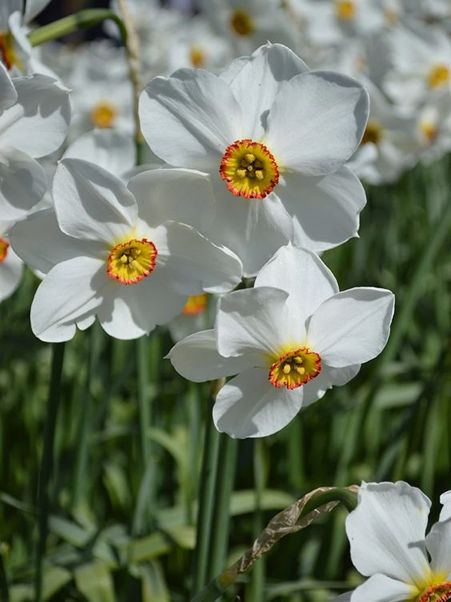
15.'Professor Einstein' Daffodil
- Native Area:Nursery hybrid
- USDA Hardiness Zones: 3–8
- Height:16–18 inches
- Sun Exposure:Full sun to partial shade
‘Professor Einstein’ is a stunning daffodil that offers garden enthusiasts with a magnificent large flower characterized by a waxy orange cup that stands out against the glistening white petals. Its flowers usually bloom in the middle of spring and are pleasantly fragrant. Additionally, this plant has the ability to naturalize well in a garden, making it an ideal choice for those looking for a low maintenance flower that comes back year after year. Moreover, deer tend to stay away from its blooms, as is the case with all daffodils, making it a suitable option for areas where deer are prevalent. The ‘Professor Einstein’ cultivar belongs to division 2, which encompasses daffodils whose center cups are at least one-third the length of the petals.




